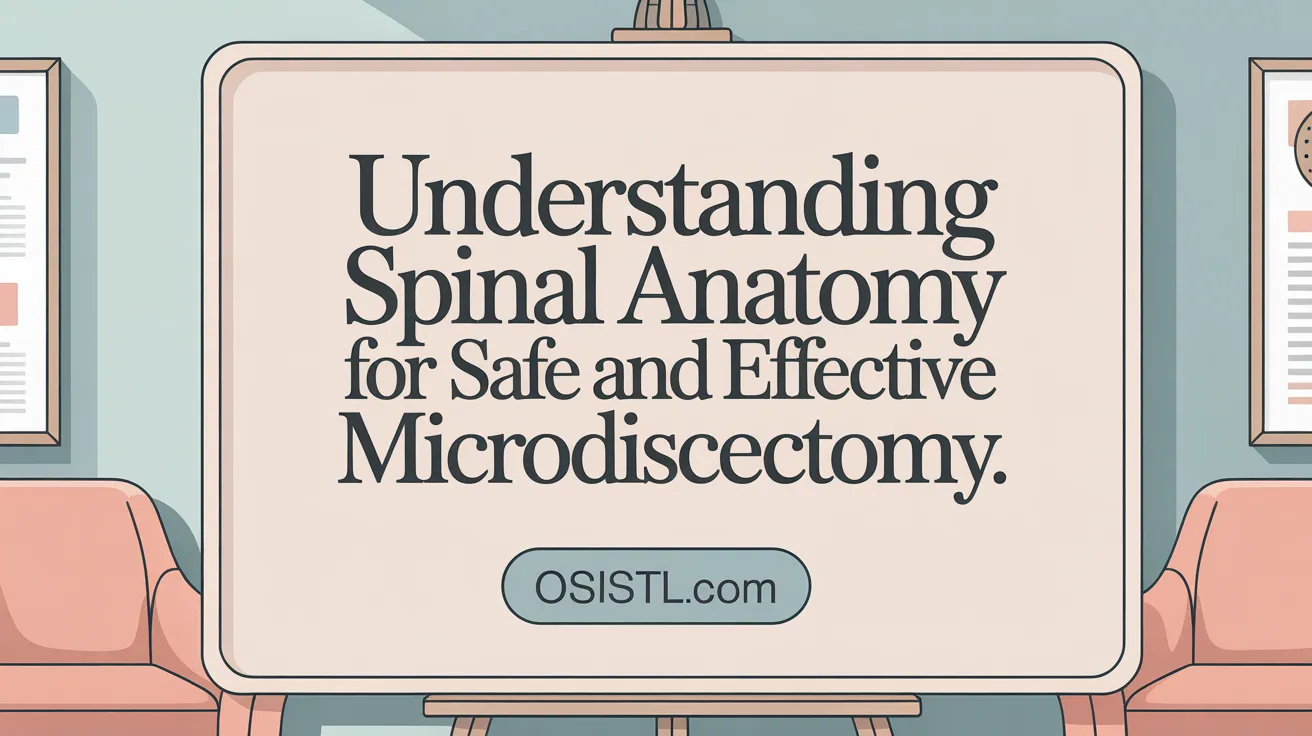Introduction to Microdiscectomy
Microdiscectomy is a widely accepted minimally invasive surgical procedure aimed at alleviating nerve root compression caused by lumbar disc herniations. This procedure offers an effective solution for patients suffering from severe leg pain, numbness, or weakness due to herniated discs, especially after conservative treatments have failed. This article provides a comprehensive step-by-step overview of the microdiscectomy procedure, including its indications, anatomical considerations, surgical techniques, preoperative preparation, postoperative care, and recovery timeline, culminating in the benefits and potential risks associated with the surgery.
What is Microdiscectomy and When is it Indicated?

What is a microdiscectomy and what does the procedure involve?
A microdiscectomy surgical procedure is a minimally invasive surgical procedure designed to remove herniated disc material that presses on nerves in the lumbar spine. It is most commonly performed at levels L4–L5 and L5–S1. The operation involves making a small, usually 1 to 2 cm, incision along the midline of the lower back. Using an operating microscope and specialized instruments, the surgeon carefully dissects muscles and removes a small part of the lamina (laminotomy) if necessary, to access the herniated disc.
During the procedure, the surgeon carefully removes the fragment of disc that is pressing on the nerve root. This decompression alleviates pain, numbness, or weakness caused by nerve compression. The minimally invasive nature of the surgery means less tissue damage, less blood loss, and a shorter hospital stay, with many patients going home the same day (Lumbar Microdiscectomy).
Most microdiscectomies are performed as outpatient procedures and have high success rates, typically between 80-90% (Microdiscectomy success rates). The outcomes are comparable to traditional open discectomy but with less postoperative pain and quicker recovery. The risks are low but can include nerve injury, dural tears, bleeding, and recurrence of herniation (Risks of lumbar microdiscectomy).
What are the indications and reasons for performing microdiscectomy?
Microdiscectomy is generally indicated for patients suffering from radiculopathy caused by a herniated lumbar disc. Common symptoms include severe leg pain, numbness, tingling, and muscle weakness that affect daily activities and do not improve with conservative treatments like medications, physical therapy, or injections (Indications for lumbar discectomy).
The procedure is especially considered when imaging studies such as MRI confirm nerve compression by the herniated disc, and symptoms persist for more than 6 to 12 weeks despite nonsurgical management (MRI evidence for discectomy candidacy). It is also used in cases where nerve compression is causing significant impairment or when symptoms are worsening. The goal of microdiscectomy is to relieve nerve pressure quickly and effectively, restoring function and reducing pain (Lumbar disc herniation surgery overview).
In summary, microdiscectomy is a highly effective surgical option for relieving nerve compression caused by herniated discs in the lower back when conservative therapy fails, improving quality of life and allowing most patients to return to normal activities within a few weeks (Lumbar microdiscectomy recovery timeline).
Anatomical and Surgical Considerations in Microdiscectomy

What anatomical structures are considered during a microdiscectomy?
In microdiscectomy, the surgeon carefully considers several vital structures to ensure safety and effectiveness. The procedure begins with exposing the vertebral bones, notably the lamina—part of the vertebral arch—and the facet joints, which stabilize the spine. These bony landmarks are crucial for orientation.
The primary target is the intervertebral disc, especially the herniated part causing nerve compression. The surgeon carefully resects this herniated fragment to decompress nearby nerve roots, primarily the spinal nerve roots that exit through foramina.
Preservation of neural structures is paramount. The nerve roots, their sleeves, and surrounding nerve tissues are identified and meticulously protected during tissue retraction and disc removal to avoid injury. Ligaments such as the ligamentum flavum, which covers the dura mater and forms part of the posterior boundary of the spinal canal, are incised or retracted to access the dural sac and nerve roots.
Surrounding musculature, especially the paraspinal muscles, is split rather than cut, reducing tissue trauma. Bony landmarks like the spinous process are used for orientation, and careful handling of vascular structures minimizes bleeding.
Overall, these considerations aim to provide a safe corridor to the affected disc while preserving spinal stability.
What surgical landmarks and tissue considerations are involved?
Surgeons rely on specific landmarks such as the spinous processes, lamina, facet joints, and the ligamentum flavum to guide the surgical approach. Proper identification prevents damage to critical neural elements.
During the approach, the ligamentum flavum is incised and dissected to reveal the dura mater and nerve root. The nerve root is then carefully mobilized to access the herniated disc material.
Preservation of facet joints is essential to maintain postoperative spinal stability. The use of magnification tools like an operating microscope enhances visualization, allowing precise tissue handling.
Tissue considerations also involve minimizing trauma to muscles and other soft tissues through a muscle-splitting approach, promoting faster recovery and less postoperative pain (discectomy recovery timeline).
What surgical techniques and approaches are used in microdiscectomy?
The most common approach is a minimally invasive posterior route. It involves a small (about 2-3 cm) midline or paramedian skin incision. Sequential dilators are inserted to gently split the paraspinal muscles, reducing muscle trauma (minimally invasive lumbar discectomy).
A tubular retractor system is secured over the dilators, providing a direct channel to the lamina and intervertebral foramen.
Using an operative microscope or high-magnification loupes, the surgeon performs a laminotomy—removing a small portion of the lamina—to expose the dura mater and nerve root.
The ligamentum flavum is carefully incised, and the dura is mobilized. The nerve root is gently retracted to access the herniated disc, which is then excised or shrunk using curettes and rongeurs.
Variations include micro-endoscopic discectomy, where an endoscope is employed, and far-lateral approaches for lateral disc herniations. These techniques aim to optimize visualization, reduce tissue damage, and improve recovery (microdiscectomy success rates).
In all approaches, meticulous attention to anatomical landmarks and tissue preservation underpins successful outcomes (discectomy surgical procedure overview).
Step-by-Step Microdiscectomy Procedure
Preoperative preparations and assessments
Before undergoing a microdiscectomy, patients typically have a thorough evaluation including medical history, physical examination, and imaging tests such as MRI or CT scans. These help confirm the diagnosis of disc herniation and identify the exact level of the affected spine.
Preparation also involves stopping blood-thinning medications like aspirin or warfarin, and avoiding anti-inflammatory drugs and herbal supplements as advised by the surgeon. Patients are often instructed to fast from midnight before surgery and may undergo medical clearance, especially if they have underlying health conditions. Ensuring good health prior to surgery reduces the risk of complications.
Detailed surgical steps
The procedure begins with administering general anesthesia, which ensures the patient is sedated and pain-free. Once asleep, the surgeon makes a small, typically 2 to 3 cm, midline incision over the affected vertebral level.
Gently, the surgeon dissects through the muscles using specialized instruments, such as dilators, to expose the lamina, which constitutes part of the vertebral arch. A small laminotomy, or partial removal of the lamina, is performed using a high-speed burr or similar tools.
The ligamentum flavum — a ligament that covers the nerve root — is incised to reveal the dura and nerve structures. Under a microscope, the surgeon carefully retracts the nerve root and removes the herniated disc material that presses against it. This alleviates nerve compression, relieving pain and neurological symptoms.
Once the herniated disc fragments are excised, the surgeon checks for adequate decompression and ensures no loose tissue remains. The area is irrigated with saline to clear debris, and the incision is closed in layers, often with dissolvable sutures.
Use of intraoperative imaging and specialized instruments
Intraoperative fluoroscopy or other imaging tools guide the surgeon in confirming the correct level of the spine and assist in precise instrument placement. Specialized instruments include Kerrison rongeurs for bone removal, curettes for disc tissue, nerve hooks for nerve mobilization, and the high-speed burr for laminotomy.
Visualization is enhanced through a surgical microscope or magnifying loupes, providing a clear view of delicate neural structures. Dilation systems and tubular retractors allow minimal muscle disruption, contributing to the procedure's minimally invasive nature. Careful handling of tissue and precise removal of herniated disc fragments help maintain spinal stability and promote faster recovery.
This meticulous approach ensures effective decompression while minimizing tissue trauma, leading to high success rates and reduced postoperative pain.
Postoperative Care and Recovery Process
What does postoperative care and the recovery process involve after a microdiscectomy?
After a microdiscectomy, the primary focus is on safe healing and preventing complications. Patients are closely monitored during the initial hours or days in the hospital or recovery area, where caregivers assess vital signs and ensure pain is managed effectively.
Pain management is a critical component of recovery. Patients typically receive prescribed medications such as anti-inflammatories, acetaminophen, or muscle relaxants to control discomfort. Using heat therapy cautiously can help reduce stiffness, but direct application over the incision should be avoided until healed.
Wound care involves keeping the surgical site clean and dry. Patients are usually instructed to leave tape or bandages in place for about a week, then gently wash the area daily with warm, soapy water. Removing sutures or staples occurs around 7-10 days, under healthcare provider guidance.
Initially, activity restrictions include avoiding heavy lifting (more than 10 pounds), bending from the waist, and twisting movements for about 6 weeks. However, gentle walking is encouraged starting within the first 24 hours, with many patients able to walk several times daily to promote blood flow and mobility.
Early mobility helps prevent blood clots and aids healing. Patients are often advised to use lumbar supports or pillows to maintain good posture and reduce strain on the back.
Driving is generally permitted around two weeks post-surgery if pain is adequately controlled and the patient can turn the head comfortably.
Role of physical therapy is crucial; it usually begins between 4 to 6 weeks post-operation. Physical therapists focus on strengthening core and back muscles, improving flexibility, and teaching proper movement techniques to prevent future injury.
Recovery duration varies but most patients see significant improvement within 6 to 8 weeks. Adherence to activity restrictions, wound care, and attending recommended physiotherapy sessions are vital for a smooth recovery and optimal long-term outcomes.
Timeline and Milestones in Microdiscectomy Recovery

What is the typical timeline and key milestones during microdiscectomy recovery?
Recovery from a microdiscectomy generally follows a pattern of gradual improvement. Most patients can expect to resume light activities, such as walking, within the first few days after surgery. Pain and discomfort usually diminish over the course of several weeks. Typically, by 4 to 6 weeks, many individuals are able to return to their regular daily activities, including work and light exercise.
Full recovery, including regaining strength and mobility, often takes several months. This duration can vary based on personal health, age, and the severity of preoperative symptoms. Postoperative milestones include initial pain relief, improved mobility, and gradually increasing activity levels. It is important to follow medical advice, participate in recommended physical therapy following discectomy, and avoid strenuous activities until cleared by the doctor.
Research and clinical experience suggest that most patients experience significant improvements within the first 12 weeks, but ongoing strengthening and conditioning are vital for optimal, long-term results.
Risks, Complications, and When to Seek Medical Help

What are the risks, potential complications, and expected outcomes associated with microdiscectomy?
Risks associated with microdiscectomy are generally low but can include infection, bleeding, nerve injury, and recurrence of a herniated disc. There is also a small chance of cerebrospinal fluid leaks, dural tears, or vascular injury, especially considering the delicate structures involved in spinal surgery. Despite these risks, most patients experience a high rate of success, with significant relief of leg pain, improved mobility, and return to normal activities in many cases.
Over 90% of patients report good to excellent outcomes, and the procedure is considered safe and minimally invasive compared to traditional open surgery. The overall goal is to decompress the nerve root, alleviate pain, and restore function, which most patients achieve. For more on risks of lumbar microdiscectomy and microdiscectomy success rates, see these resources.
What signs of complications should patients watch for after microdiscectomy, and when should they seek medical attention?
Postoperative warning signs include increasing or severe pain at the surgical site, redness, swelling, or discharge which may indicate infection. Fever is another important sign that warrants immediate medical assessment.
Patients should also be vigilant for new or worsening neurological symptoms such as weakness, numbness, or tingling in the legs, or loss of bladder or bowel control, as these could signal nerve damage or more serious conditions like cauda equina syndrome.
Persistent or escalating symptoms beyond the initial recovery period require prompt medical evaluation. Early detection and management of complications are crucial for preventing long-term issues and optimizing recovery.
In case of severe symptoms such as difficulty walking, severe pain uncontrolled by medication, or signs of bleeding or infection, patients should contact their healthcare provider immediately or seek emergency care. Monitoring these signs helps ensure timely intervention, reducing the risk of permanent damage or other serious health consequences. For detailed guidance on signs of complications after microdiscectomy and when to seek emergency care, please refer to these resources.
More information
For further details on microdiscectomy complications and warning signs, searching terms like ‘Microdiscectomy complications and warning signs’ on medical databases or consulting with a spine specialist is recommended. Awareness of potential risks and early signs of problems can significantly improve treatment outcomes. Additional comprehensive information can also be found in these resources on lumbar microdiscectomy and postoperative care for microdiscectomy.
Benefits of Microdiscectomy and Frequently Asked Questions

What are the main benefits and expected improvements following microdiscectomy surgery?
Most patients experience significant relief from leg pain, numbness, and weakness caused by nerve compression due to a herniated disc. The procedure often results in rapid symptom improvement, with many patients noticing immediate or gradual improvement over days to weeks. Advantages include smaller incisions, less tissue trauma, shorter hospital stays, and a quicker recovery process compared to traditional open surgery. These benefits translate into a faster return to daily activities, work, and physical function. Additionally, microdiscectomy preserves spinal stability and minimizes complications, making it a highly effective option for suitable candidates.
What are some frequently asked questions about microdiscectomy surgery?
Patients commonly ask about the overall success rate, with most studies reporting over 90% satisfaction and symptom relief. Many want to know how soon they can return to normal activities or work—typically within a few weeks to a couple of months. Concerns about pain management, activity restrictions, and the need for physical therapy are also frequent. Patients inquire about potential risks, such as infection, nerve injury, recurrence, and how these issues are managed if they occur. Questions about postoperative care include incision hygiene, signs of infection, and understanding what to expect during recovery phases. People also want to know how long they should avoid strenuous activities and what precautions they should take to prevent recurrence or complications. See more postoperative care details.
Recovery expectations and safety
Post-surgery, most patients are able to leave the hospital the same day or after an overnight stay. Recovery involves managing pain, caring for the incision, and gradually resuming activities. Physical therapy may be recommended to strengthen back muscles and improve mobility. The majority of patients return to work in around 2-6 weeks, depending on their individual progress. While the procedure boasts a high success rate and low complication risks, it is important to follow postoperative instructions carefully. Monitoring for signs of infection, nerve issues, or recurrence is crucial. Overall, microdiscectomy is considered a safe, minimally invasive surgical option with excellent long-term outcomes for appropriately selected patients.
Conclusion
Microdiscectomy remains a gold standard surgical option for treating lumbar disc herniation with symptomatic nerve compression, providing significant relief for patients suffering from sciatica and related symptoms. With advances in minimally invasive techniques, this procedure causes less tissue trauma, allowing quicker recovery and lower risk of complications compared to traditional open surgery. Understanding the step-by-step process, preoperative preparation, and postoperative care promotes informed decision-making and optimal outcomes. While risks exist, they are generally low, and vigilant postoperative monitoring ensures early detection of complications. Through careful patient selection and multidisciplinary management, microdiscectomy effectively restores function and quality of life for the majority of patients.
